This month was full of quiet things. There's a certain realization after months of unemployment that something needs to change, but shy of hiring yourself, there aren't a lot of options. We've been feeling the pinch. Perhaps more in the head than the wallet - the idle time has been nice, but it occasionally borders on stir crazy. Thankfully, change is in progress.
Last Thursday marked the beginning of a weekend: Renewable Energy Roundup weekend. Last year my duties were tending the vendor gate and serving the beer on Sunday morning. This year, with Matt in tow, I opted to take it easy with a three hour beer shift on Friday evening. Sure enough, the regular coordinators, volunteers and vendors were milling around and it felt like a somewhat long lost collection of friends. A few of my friends (3 from Abilene, one from Rolla, MO) even made it down to join in the geekfest. Honestly, it wasn't all that geeky, but it's great to have a crowd of folks interested in conservation and avoiding unsustainable status quo.
Last Thursday also marked a series of phone calls in which I was offered a position as a zoo keeper with the bird department at the City of Waco's Cameron Park Zoo. The following phone calls confirmed that the wind farm monitoring job that I left in April was losing all of its funding. In October. So instead of three to four years of monitoring, two is the end of the story. Do the world a favor and boycott big wind farms. My current definition of "big" is more than a single-digit turbine cluster of wind turbines that exceed 50' in height.
We returned from Kerrville yesterday, leaving the solitude of the river to fight I-35 traffic so I could make the two physicals scheduled for this morning. Baby steps. On the bright side, I should be learning the ropes by the end of this week.
Until next time, I'll dream of living at the mcfarthest place in the United States. Seriously.
28 September 2009
16 September 2009
11 September 2009
Western Spindalis FL 2009 revisited
Edit: The RBA portion was originally posted 7/29/09 at 8:45 pm, then censored upon request for the sake of nest privacy, and is now back as the unedited RBA submission with some discussion. I cannot thank Patricia Auffhammer enough for keeping us in the loop as to the progression of events, every update has been a refreshing reminder of our sweltering mosquito adventure.
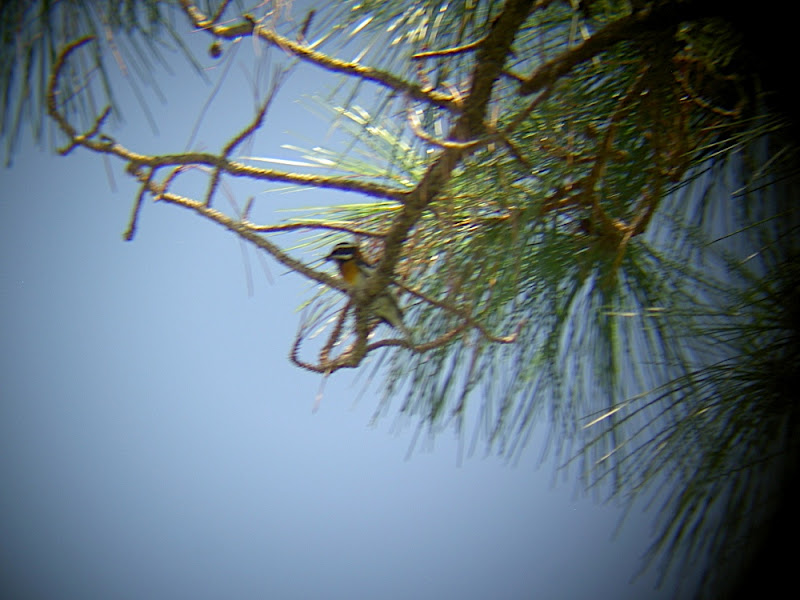
(the original super-awesome digi-bin photo)
Below is the result of your feedback form. It was submitted by Heidi Trudell & Matthew York on Wednesday, July 29, 2009 9:44 PM
---------------------------------------------------------------------------
01. Common Name Western Spindalis
02. Scientific Name Spindalis zena
03. Number Of Individuals: 2
04. Age: adult
05. Sex: male and female
06. Date Observed: July 28, 2009
07. Time Of Day: Noon
08. Duration Of Observation: 45 minutes
09. Sky Conditions: Bright and clear
10. Exact Location: [the birds are still around, and in a sensitive state right now - fledging - and the folks who currently have the locations posted should think long and hard about raising little ones]
11. Habitat: Pine flatwoods with mixed palmetto understory.
12. Distance From Bird: 5 meters at closest, 20 on average
13. Optical Equipment: 8x42 and 10x42 binoculars
14. Relationship of Sun/Observer/Bird: Initial observations ranged from optimal (sun at our backs while watching the birds) to poorly silhouetted.
15. Others Who Saw Bird: Matthew York
16. Others Who Independently IDed Bird: Matthew York
17. Anyone Known To Disagree: -
18. Vocalizations: Male was silent at first observation, plaintively cheeped a high, thin note - was responded to by female in similar fashion. When the pair flew off together, both chirped the single notes. After ~20 mins of observation, the male perched in the pines above the "do not enter" sign and sang a high, thin series of "weeky weeky" squeaking into buzzy notes (reminiscent of Black & White Warbler). He preened and sang intermittently for about 5 minutes.
19. Behavior: First sighting of male was at eye-level in understory edge, along the road. He then flew up into the higher branches of a pine, carrying a thin strand of vegetation. He flew deeper into the pines and returned shortly without the veg. After the male dropped into the understory, the female flew in from across the road and both flew back towards where the female had come from (both chipping throughout the interaction). A while later, the male was seen thoroughly preening and singing in upper pine branches - the female perched high in the pines across the road from the residence, also preening thoroughly. She would occasionally vanish into the understory across from the residence and tended to stay on that side of the road.
20. Description: Male - Initial impression was bold dark/white contrast on wing, reminiscent of male Rose-breasted Grosbeak. The head was a stark black & white pattern (white supercilium and malar) above a sunset "v" on the breast that extended to the nape, with white belly and pale vent contrasting with a dark tail. Overall impression was a somewhat stocky bird (grosbeak or towhee in size/posture - barely larger than nearby warblers though), with a slim beak.
Female - Overall a nondescript brown bird of similar size and shape of the male. Pale belly and vent contrasted with darker tail.
21. Species Eliminated And Why: Black-headed Grosbeak - beak was too slim, facial patterns wrong. Bananaquit - size, posture, beak and behavior didn't fit.
22. Previous Experience With This Species: None
23. Previous Experience With Similar Species: Black-headed Grosbeak - Matthew and I have lived in their range for several years, seeing all ages and plumages several times per year. Bananaquit - I spent a week with them in Grand Cayman.
24. ID'd Before Consulting Guides: Yes
25. What Influenced Your Decision: Absolute conspicuous coloration of the male, unmistakable recognition from memorizing the field guide (for Matthew, anyway). The female was guilty by association - vocalization, size and behavior.
26. Materials Submitted: http://picasaweb.google.com/seetrail/WesternSpindalisX2#
27. Observer Name: Heidi Trudell & Matthew York
End of report.
For browsing convenience, the link to seetrail's Western Spindalis album
Other blogs/posts/videos about these birds can be found...
on the ABA/Peeps blog - several details are incorrect
this TAS post by Larry Manfredi seems to have been the source for Peeps
Larry's Manfredi's site has a report with photos - several details are incorrect
and there are some videos at Wil Domke's site
here's Larry's original post, and here's the birdingonthe.net link
which is linked from the Near Georgia Report as well
Most of the confusion seems to be about what behaviors led to these birds being shrouded in secrecy. My first look at the male spindalis was this: pine needle in beak. Males don't just carry veg for fun. Matt noted that it took off for a tree-top location and vanished for a little while, hence our nest speculation began.
I'd like to also take a moment and point out ABA's code of ethics - anyone knowing about the nest who posted more details than "the spindalis are alive at an undisclosed location" would be seriously in question, ethically. My initial flaw when reporting the birds was that I mentioned 2 birds and the location. Matt and I knew that they occurred pretty much annually in FL and didn't think much of seeing 2 of them... other than the excitement of a ridiculously exciting new life bird for both of us. My initial post on the TAS list probably should have been much more vague as to the whereabouts of the birds, but being on vacation with spotty internet access, I didn't want to return to a million new e-mails. Selfish motives. Many people graciously removed locations when they were asked - it took quite a bit of cooperation to backtrack, including removing blogs from being searchable by Google and whatnot.
Here's the first e-mail sent - it's addressed to Michael Retter, a dear friend. It follows a phone conversation in which I was somewhat confused over how many "drab" birds were present (one being scruffier than the other, I thought might have been juv, but never quite had enough looks at the second bird to conjure up any other thoughts).
Michael,
Upon further review of the pictures and notes, it's probably just 2 ...whatever the plural of "Spindalis" is. What I thought might have been juv. was probably just the female again.
Matt and I drove to [the designated area] and gawked at a few Pine Warblers there for a few minutes before slowly heading out again. We had exited the [main area] and were almost to the [specific area] (on the left) when I spotted a bulky, black-and-white bird at about eye level in the undergrowth - maybe 15 meters from [a driveway]. It was just before noon - my camera is a few minutes off on the time stamp, but the bird flew up into a distinctly "curly" pine, carrying a pine needle (this is still on the left side of the road) and surfaced after a few moments (without the pine needle), allowing the first set of pictures to be taken. At this point we were only seeing the adult male. Since Matt and I were in the area for ~45 mins, I'm not clear as to what time the female showed up, it had to have been after at least 10-15 mins from the initial sighting. The male would "chip" occasionally when we were on him and at some point, a pale, drab bird flew over from the right side of the road to the left, into the low shrub where the male was - the looks at this bird were fleeting, all I saw while it was perched was a pale vent on darker tail feathers - but they flew back across to the right side of the road together and vanished mid-level. At this point there was snacking and at some point the male perched high in a pine at [a spot], above [a landmark], where he preened and sang and preened.. and preened. A bit later, Matt spotted the drab bird on the resident's side of the road, perched high and preening frequently. All of our pictures of this bird are sadly back-lit, but we were able to follow the two enough to determine that they chipped alike.
Anyway, the closest we ever saw the critters would be ~10 meters in the low shrub, ~30 meters when across the road, but roughly 20-30 mins of observation of the 45 we were aware of them.
I'm not sure of their nesting habits, but having watched nesting vireos all summer, the ridiculously frequent preening and veg carry could indicate nesting and/or incubation - my shots of the female clearly show a very fluffed belly, which was fairly typical of a female vireo when immediately off-nest.
Let me know what other details might be useful for a report, we may have a few more details that didn't make the notes. We may not have the internet though =)
All the best,
-heidi
*****
Moral of the post:
Please, go forth, bird in the summer and find stuff. But please, for the love of nest predation and stress, DO NOT post sensitive information until it has cleared with all concerned parties!
(the original super-awesome digi-bin photo)
Below is the result of your feedback form. It was submitted by Heidi Trudell & Matthew York on Wednesday, July 29, 2009 9:44 PM
---------------------------------------------------------------------------
01. Common Name Western Spindalis
02. Scientific Name Spindalis zena
03. Number Of Individuals: 2
04. Age: adult
05. Sex: male and female
06. Date Observed: July 28, 2009
07. Time Of Day: Noon
08. Duration Of Observation: 45 minutes
09. Sky Conditions: Bright and clear
10. Exact Location: [the birds are still around, and in a sensitive state right now - fledging - and the folks who currently have the locations posted should think long and hard about raising little ones]
11. Habitat: Pine flatwoods with mixed palmetto understory.
12. Distance From Bird: 5 meters at closest, 20 on average
13. Optical Equipment: 8x42 and 10x42 binoculars
14. Relationship of Sun/Observer/Bird: Initial observations ranged from optimal (sun at our backs while watching the birds) to poorly silhouetted.
15. Others Who Saw Bird: Matthew York
16. Others Who Independently IDed Bird: Matthew York
17. Anyone Known To Disagree: -
18. Vocalizations: Male was silent at first observation, plaintively cheeped a high, thin note - was responded to by female in similar fashion. When the pair flew off together, both chirped the single notes. After ~20 mins of observation, the male perched in the pines above the "do not enter" sign and sang a high, thin series of "weeky weeky" squeaking into buzzy notes (reminiscent of Black & White Warbler). He preened and sang intermittently for about 5 minutes.
19. Behavior: First sighting of male was at eye-level in understory edge, along the road. He then flew up into the higher branches of a pine, carrying a thin strand of vegetation. He flew deeper into the pines and returned shortly without the veg. After the male dropped into the understory, the female flew in from across the road and both flew back towards where the female had come from (both chipping throughout the interaction). A while later, the male was seen thoroughly preening and singing in upper pine branches - the female perched high in the pines across the road from the residence, also preening thoroughly. She would occasionally vanish into the understory across from the residence and tended to stay on that side of the road.
20. Description: Male - Initial impression was bold dark/white contrast on wing, reminiscent of male Rose-breasted Grosbeak. The head was a stark black & white pattern (white supercilium and malar) above a sunset "v" on the breast that extended to the nape, with white belly and pale vent contrasting with a dark tail. Overall impression was a somewhat stocky bird (grosbeak or towhee in size/posture - barely larger than nearby warblers though), with a slim beak.
Female - Overall a nondescript brown bird of similar size and shape of the male. Pale belly and vent contrasted with darker tail.
21. Species Eliminated And Why: Black-headed Grosbeak - beak was too slim, facial patterns wrong. Bananaquit - size, posture, beak and behavior didn't fit.
22. Previous Experience With This Species: None
23. Previous Experience With Similar Species: Black-headed Grosbeak - Matthew and I have lived in their range for several years, seeing all ages and plumages several times per year. Bananaquit - I spent a week with them in Grand Cayman.
24. ID'd Before Consulting Guides: Yes
25. What Influenced Your Decision: Absolute conspicuous coloration of the male, unmistakable recognition from memorizing the field guide (for Matthew, anyway). The female was guilty by association - vocalization, size and behavior.
26. Materials Submitted: http://picasaweb.google.com/seetrail/WesternSpindalisX2#
27. Observer Name: Heidi Trudell & Matthew York
End of report.
For browsing convenience, the link to seetrail's Western Spindalis album
Other blogs/posts/videos about these birds can be found...
on the ABA/Peeps blog - several details are incorrect
this TAS post by Larry Manfredi seems to have been the source for Peeps
Larry's Manfredi's site has a report with photos - several details are incorrect
and there are some videos at Wil Domke's site
here's Larry's original post, and here's the birdingonthe.net link
which is linked from the Near Georgia Report as well
Most of the confusion seems to be about what behaviors led to these birds being shrouded in secrecy. My first look at the male spindalis was this: pine needle in beak. Males don't just carry veg for fun. Matt noted that it took off for a tree-top location and vanished for a little while, hence our nest speculation began.
I'd like to also take a moment and point out ABA's code of ethics - anyone knowing about the nest who posted more details than "the spindalis are alive at an undisclosed location" would be seriously in question, ethically. My initial flaw when reporting the birds was that I mentioned 2 birds and the location. Matt and I knew that they occurred pretty much annually in FL and didn't think much of seeing 2 of them... other than the excitement of a ridiculously exciting new life bird for both of us. My initial post on the TAS list probably should have been much more vague as to the whereabouts of the birds, but being on vacation with spotty internet access, I didn't want to return to a million new e-mails. Selfish motives. Many people graciously removed locations when they were asked - it took quite a bit of cooperation to backtrack, including removing blogs from being searchable by Google and whatnot.
Here's the first e-mail sent - it's addressed to Michael Retter, a dear friend. It follows a phone conversation in which I was somewhat confused over how many "drab" birds were present (one being scruffier than the other, I thought might have been juv, but never quite had enough looks at the second bird to conjure up any other thoughts).
Michael,
Upon further review of the pictures and notes, it's probably just 2 ...whatever the plural of "Spindalis" is. What I thought might have been juv. was probably just the female again.
Matt and I drove to [the designated area] and gawked at a few Pine Warblers there for a few minutes before slowly heading out again. We had exited the [main area] and were almost to the [specific area] (on the left) when I spotted a bulky, black-and-white bird at about eye level in the undergrowth - maybe 15 meters from [a driveway]. It was just before noon - my camera is a few minutes off on the time stamp, but the bird flew up into a distinctly "curly" pine, carrying a pine needle (this is still on the left side of the road) and surfaced after a few moments (without the pine needle), allowing the first set of pictures to be taken. At this point we were only seeing the adult male. Since Matt and I were in the area for ~45 mins, I'm not clear as to what time the female showed up, it had to have been after at least 10-15 mins from the initial sighting. The male would "chip" occasionally when we were on him and at some point, a pale, drab bird flew over from the right side of the road to the left, into the low shrub where the male was - the looks at this bird were fleeting, all I saw while it was perched was a pale vent on darker tail feathers - but they flew back across to the right side of the road together and vanished mid-level. At this point there was snacking and at some point the male perched high in a pine at [a spot], above [a landmark], where he preened and sang and preened.. and preened. A bit later, Matt spotted the drab bird on the resident's side of the road, perched high and preening frequently. All of our pictures of this bird are sadly back-lit, but we were able to follow the two enough to determine that they chipped alike.
Anyway, the closest we ever saw the critters would be ~10 meters in the low shrub, ~30 meters when across the road, but roughly 20-30 mins of observation of the 45 we were aware of them.
I'm not sure of their nesting habits, but having watched nesting vireos all summer, the ridiculously frequent preening and veg carry could indicate nesting and/or incubation - my shots of the female clearly show a very fluffed belly, which was fairly typical of a female vireo when immediately off-nest.
Let me know what other details might be useful for a report, we may have a few more details that didn't make the notes. We may not have the internet though =)
All the best,
-heidi
*****
Moral of the post:
Please, go forth, bird in the summer and find stuff. But please, for the love of nest predation and stress, DO NOT post sensitive information until it has cleared with all concerned parties!
06 September 2009
SW thumbs, day 8
As mentioned in one of the earlier posts, our visit coincided with one of the busiest two weekends of the year, Indian Market. Since Matt and I were both familiar with the blankets-on-sidewalk weekend sort of market, we decided to check out this giant fest of green chili cheese bread (sorry, ate it without pictures), fashion shows (too crowded to see), and absolutely mind-boggling pottery and sculpture and jewelery and paintings. Admittedly, there was one fellow who was selected for his feather work and a photographer posed the fellow where Matt and I had been sitting.

To backtrack for a moment, since we got there really early and walked a few of the side streets before delving into the crowds, I snapped a few quiet pictures: looking up towards a courtyard, and a set of adobe-clad french doors that still managed to produce a strong reflection. I do admire adobe construction because it tends to favor glass surfaces that are not as risky for birds.
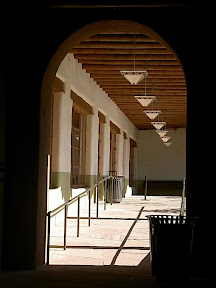
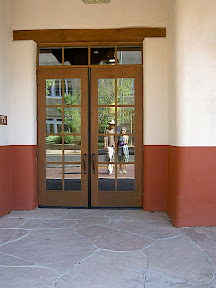
I didn't photograph the crowd (we heard French, Spanish, some British accents, etc), nor the art - I hope the 2009 video will make up for at least the art portion.
On our way back from the market, we passed another fine example of local art. The Mona Lisa on the corner of the Paseo and Bishop's Lodge:

Knowing that our last day was all too rapidly drawing to an end, Matt suggested one final visit to Randall Davey Audubon Center. This time I managed to get a less blurry photo of the tricolored bumble bee (noted by its bright orange stripe) and the crazy white bees that seem to be Xeromelecta sp (methinks). One of our familiar Waco moths - the corn earworm moth - was there as well.
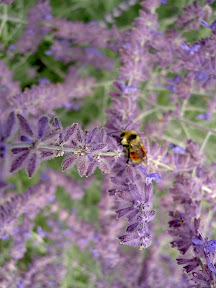

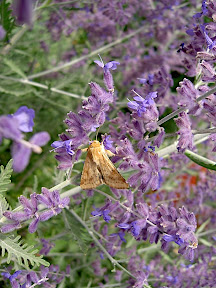
tricolored bumble bee (Bombus ternarius, Xeromelecta sp(?), corn earworm moth (Helicoverpa zea)
Finally, we also cornered a non-snake herp for the trip - a shy, but photogenic Five-lined Skink. Skinks are pretty much glossy lizards, extremely fast and often only detectable by the rustling of leaf litter. This fellow was basking at RDA's amphitheater, much to our pleasant surprise.
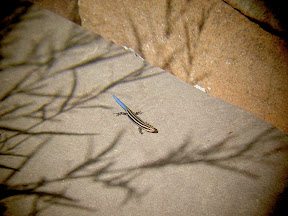
Five-lined Skink (Eumeces fasciatus)
As promised, this post does contain more exciting creatures than humans, insects and a skink. Hardly human, but the bestest SUPERhuman: Grandma! When we got back from RDA, it was time for dinner and we got to hang out with our cousinlet's favorite superhuman in the whole wide world. Hopefully she'll forgive me for intruding on her Grandma time...
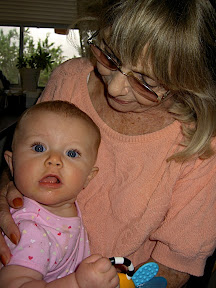

Grandma time was followed by bouncy chair time, which was full of colorful objects that spun and could not be dropped or thrown. Happy noises ensued. The rest of us were even able to eat because she was so distracted.


The evening was also full of love. And waggles. And playing catch. And so ended our NM trip...

Matt's fan club: Blue (peeler of the tennis ball) and Bobby (Grandma's puppy).
To backtrack for a moment, since we got there really early and walked a few of the side streets before delving into the crowds, I snapped a few quiet pictures: looking up towards a courtyard, and a set of adobe-clad french doors that still managed to produce a strong reflection. I do admire adobe construction because it tends to favor glass surfaces that are not as risky for birds.
I didn't photograph the crowd (we heard French, Spanish, some British accents, etc), nor the art - I hope the 2009 video will make up for at least the art portion.
On our way back from the market, we passed another fine example of local art. The Mona Lisa on the corner of the Paseo and Bishop's Lodge:
Knowing that our last day was all too rapidly drawing to an end, Matt suggested one final visit to Randall Davey Audubon Center. This time I managed to get a less blurry photo of the tricolored bumble bee (noted by its bright orange stripe) and the crazy white bees that seem to be Xeromelecta sp (methinks). One of our familiar Waco moths - the corn earworm moth - was there as well.

tricolored bumble bee (Bombus ternarius, Xeromelecta sp(?), corn earworm moth (Helicoverpa zea)
Finally, we also cornered a non-snake herp for the trip - a shy, but photogenic Five-lined Skink. Skinks are pretty much glossy lizards, extremely fast and often only detectable by the rustling of leaf litter. This fellow was basking at RDA's amphitheater, much to our pleasant surprise.
Five-lined Skink (Eumeces fasciatus)
As promised, this post does contain more exciting creatures than humans, insects and a skink. Hardly human, but the bestest SUPERhuman: Grandma! When we got back from RDA, it was time for dinner and we got to hang out with our cousinlet's favorite superhuman in the whole wide world. Hopefully she'll forgive me for intruding on her Grandma time...
Grandma time was followed by bouncy chair time, which was full of colorful objects that spun and could not be dropped or thrown. Happy noises ensued. The rest of us were even able to eat because she was so distracted.

The evening was also full of love. And waggles. And playing catch. And so ended our NM trip...

Matt's fan club: Blue (peeler of the tennis ball) and Bobby (Grandma's puppy).
05 September 2009
Waco beetle invasion
We interrupt your regularly scheduled "SW adventures, day 8" post to bring you an invasion of beetles! We're back in Waco, and there are beetles everywhere.
It's like the end of the world - but it's not! This afternoon, Matt summoned me to the backyard to investigate what looked like a swarm of low-flying cicadas. They seemed a bit small for the regular beasts, but certainly bonked into trees, fences and walls often enough. I grabbed the camera and Matt grabbed the field guide and with our forces combined, we bring to you the Fig Beetle (Cotinis mutabilis):
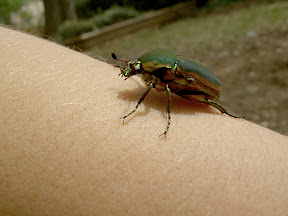
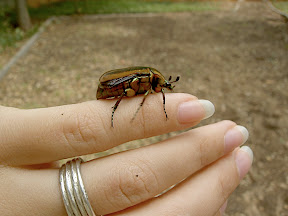
There must have been about two dozen of the creatures loitering about the yard. Most hovered 1-3 feet off the ground, some snuck over the fence into the neighbor's yard and others levitated into the trees. Oddly enough, they are far more skilled at their flight navigation than cicadas, bonking into pretty much everything except Matt, Anakin and myself. Puppy paid no attention unless one zoomed past his nose, which garnered only the turn of his head in response.
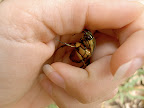

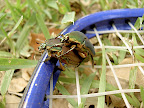
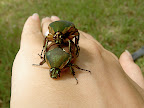
Of course, having seen a few of these before (singly or dead), I somehow deemed them unthreatening enough to pick up. Indeed, I survived. Even the pair that was mating was unphased by close photography. Apparently Fig Beetles are considered a crop pest (they seem to favor skinned fruit), but they're quite endearing...
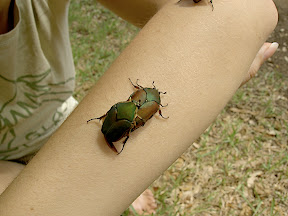
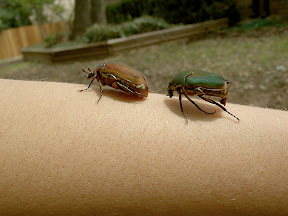
From our simple observations with the pair above, our guess is that the female tends to be a bit wider than the male. You can also see a little bit of color difference, but that could just be individual variation. A bit more reference digging will be fun. They seem to have surfaced just after our first decent rain in months. When the critters did land, they either made a beeline to the top of the nearest vegetation to climb to the top and fly away... or they headed directly under the nearest bit of leaf debris.

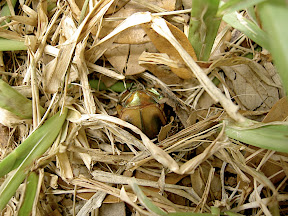
Itchy little feet, they have. But very photogenic, regardless. Matt was kind enough to take the portrait of me, below - and I snuck a portrait of him with his little crawly buddy.
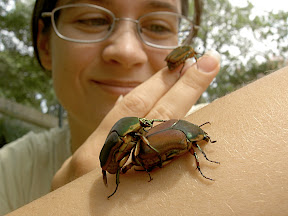
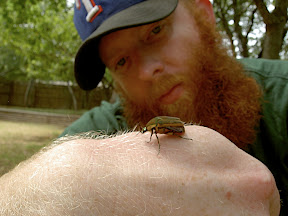
...and now we return you to your regularly scheduled blog perusal. Day 8 will be up shortly!
It's like the end of the world - but it's not! This afternoon, Matt summoned me to the backyard to investigate what looked like a swarm of low-flying cicadas. They seemed a bit small for the regular beasts, but certainly bonked into trees, fences and walls often enough. I grabbed the camera and Matt grabbed the field guide and with our forces combined, we bring to you the Fig Beetle (Cotinis mutabilis):
There must have been about two dozen of the creatures loitering about the yard. Most hovered 1-3 feet off the ground, some snuck over the fence into the neighbor's yard and others levitated into the trees. Oddly enough, they are far more skilled at their flight navigation than cicadas, bonking into pretty much everything except Matt, Anakin and myself. Puppy paid no attention unless one zoomed past his nose, which garnered only the turn of his head in response.
Of course, having seen a few of these before (singly or dead), I somehow deemed them unthreatening enough to pick up. Indeed, I survived. Even the pair that was mating was unphased by close photography. Apparently Fig Beetles are considered a crop pest (they seem to favor skinned fruit), but they're quite endearing...
From our simple observations with the pair above, our guess is that the female tends to be a bit wider than the male. You can also see a little bit of color difference, but that could just be individual variation. A bit more reference digging will be fun. They seem to have surfaced just after our first decent rain in months. When the critters did land, they either made a beeline to the top of the nearest vegetation to climb to the top and fly away... or they headed directly under the nearest bit of leaf debris.
Itchy little feet, they have. But very photogenic, regardless. Matt was kind enough to take the portrait of me, below - and I snuck a portrait of him with his little crawly buddy.
...and now we return you to your regularly scheduled blog perusal. Day 8 will be up shortly!
04 September 2009
SW thumbs, day 7
Yes, it did take a while to post "day 7" for the trip - and there's not too much to it. It was an easy, relaxing day. We went to Randall Davey Audubon Center again in the evening, and all of the day's photos are from there.
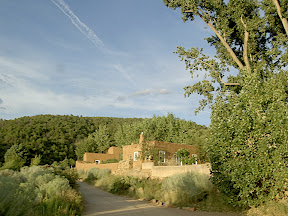
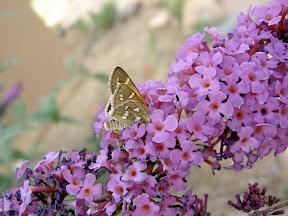
driving in, and our first butterfly of the evening
Yes, looking at the bug on the flower, we thought something was wrong - perhaps an assassin bug attached to the front of the butterfly. Nope. Perhaps earlier, but the little fellow was very much deceased. New butterfly for both of us though! Pahaska Skipper (Hesperia pahaska) is probably a flighty species when alive but, as with many other species, is quite cooperative when dead.


Pahaska Skipper (Hesperia pahaska)
The butterfly garden was also home to about half a dozen hummingbird feeders that were swarming with Broad-tailed and Black-chinned Hummingbirds (and one Rufous!) In the photos below, you can see the distinctly rufous vest of the Broad-tail (the bird in flight is a young male - you can see one spot of gorget/throat coloring). Ruby-throats are their eastern counterparts, with shorter tails and a green vest.
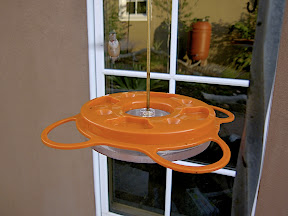

Broad-tailed Hummingbird (Selasphorus platycercus)
For the ultimate in entomological coolness, one of our finds was Adejeania vexatrix - it's so cool that for a common name, it has "red Tachinid Fly" and it's so cool that it's even in a monotypic genus! Here's the bugguide page for it.
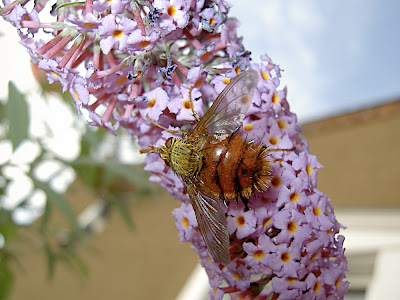

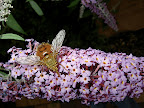
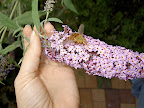
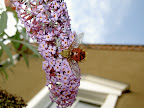
Another exciting find was a tri-colored bumblebee - blurry photo, sadly. And another bumblebee of sorts (R), I think tomorrow's pictures will cough up the white bee that was all over the place...
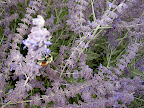
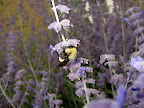
And for your human photo element of the day:
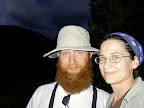
Day 8 will be a bit more diverse, in terms of culture and creatures!
driving in, and our first butterfly of the evening
Yes, looking at the bug on the flower, we thought something was wrong - perhaps an assassin bug attached to the front of the butterfly. Nope. Perhaps earlier, but the little fellow was very much deceased. New butterfly for both of us though! Pahaska Skipper (Hesperia pahaska) is probably a flighty species when alive but, as with many other species, is quite cooperative when dead.
Pahaska Skipper (Hesperia pahaska)
The butterfly garden was also home to about half a dozen hummingbird feeders that were swarming with Broad-tailed and Black-chinned Hummingbirds (and one Rufous!) In the photos below, you can see the distinctly rufous vest of the Broad-tail (the bird in flight is a young male - you can see one spot of gorget/throat coloring). Ruby-throats are their eastern counterparts, with shorter tails and a green vest.
Broad-tailed Hummingbird (Selasphorus platycercus)
For the ultimate in entomological coolness, one of our finds was Adejeania vexatrix - it's so cool that for a common name, it has "red Tachinid Fly" and it's so cool that it's even in a monotypic genus! Here's the bugguide page for it.
Another exciting find was a tri-colored bumblebee - blurry photo, sadly. And another bumblebee of sorts (R), I think tomorrow's pictures will cough up the white bee that was all over the place...
And for your human photo element of the day:
Day 8 will be a bit more diverse, in terms of culture and creatures!
Subscribe to:
Posts (Atom)















